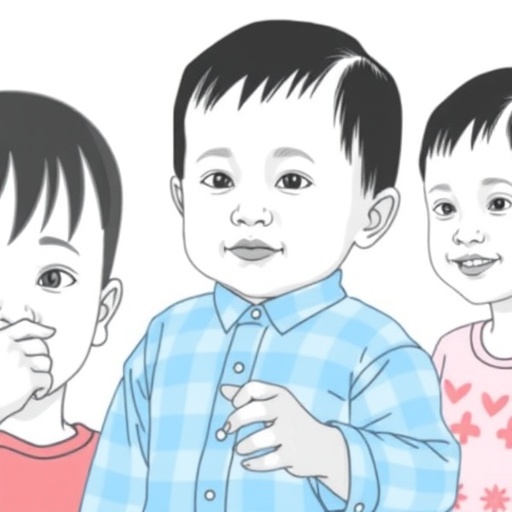In a groundbreaking study, researchers Li, Chen, and Sun investigate the agreement between children’s self-reports and proxy-reports regarding their health utility. Conducted in a school-based setting in China, this study utilizes two specific measurement tools—the EQ-5D-Y and the CHU-9D—crafted to assess health-related quality of life from multiple perspectives. This research addresses a vital question in pediatric health care: how accurately do children communicate their health status compared to proxy reports from parents or guardians?
Health-related quality of life is a critical aspect of pediatric health assessments. Children, being in the formative stages of their cognitive and emotional development, present unique challenges when it comes to self-reporting their health. Traditionally, proxy-reports have been relied upon, primarily due to assumptions about children’s reliability in reporting their health experiences. This study seeks not only to identify the level of agreement between these two reporting methods but also to highlight any significant discrepancies that may exist.
Both the EQ-5D-Y and CHU-9D are validated measures used internationally to gauge children’s health utility. The EQ-5D-Y is an adaptation of the adult EQ-5D, specifically designed for children aged 8-15 years, focusing on five dimensions: mobility, self-care, usual activities, pain/discomfort, and anxiety/depression. Meanwhile, the CHU-9D is a nine-item measure that captures health-related quality of life for children aged 7-17, addressing more nuanced aspects that the EQ-5D-Y might overlook. The utilization of these tools ensures that a comprehensive analysis of children’s health perceptions is undertaken.
The implementation of the study involved a diverse sample of children drawn from various schools across China, effectively ensuring a representational snapshot. Researchers conducted surveys in a controlled environment where children could provide their responses without external pressure. Importantly, this methodological strategy strengthens the validity of the findings, allowing for a clearer comparison between self-reports and proxy-reports from parents or guardians.
Results thus far suggest a fascinating divergence in reporting perspectives. In many cases, children reported their health utility in ways that differed significantly from their proxies. Proxies, often underestimating the challenges faced by the children, may report a more favorable health utility than the children themselves. These findings shine a light on the importance of considering children’s voices in health assessments, as they provide essential insights that proxy-reports alone could overlook.
Part of the findings can also be attributed to the emotional and psychological dimensions of health that children are more attuned to than their parents. Young individuals, particularly in specific developmental stages, might perceive pain, discomfort, or anxiety in ways that adults cannot fully understand. This disconnect raises critical questions about how health care providers assess and engage with the pediatric population, as medical decisions could be influenced by inaccurate representations of children’s health statuses.
Notably, the implications of this research extend beyond academic inquiry. Instead, they have real-world applications in clinical settings where health decision-making practices rely heavily on accurate health utility reporting. Understanding the nuances between self-reports and proxy-reports could fundamentally change approaches to assessing children’s health, thereby fostering improved health outcomes.
Moreover, this research accentuates the need for enhanced communication strategies between health care professionals and children. By adopting assessment tools that prioritize children’s self-reports, professionals can create a more inclusive and responsive healthcare environment that values children’s perspectives. It also emphasizes the need for training health professionals to recognize the potential biases in proxy-reports and to foster dialogues that encourage children to express their health experiences candidly.
The study’s findings can serve as a catalyst for further research exploring larger populations and various cultural contexts. Comparing findings across different countries could enrich understanding and refine methodologies in children’s health utility assessments. Future studies could also explore longitudinal data to understand how children’s self-perception of health evolves over time and how these changes correlate with their overall health outcomes.
Furthermore, it becomes evident that researchers, educators, and policymakers must focus on designing systems and frameworks that encourage self-reporting among children. Teaching children effective ways to communicate their feelings and experiences related to health could serve as an empowering tool. Educational programs aimed at fostering self-expression could yield a generation of children who are not only more aware of their health but also more capable of communicating these aspects effectively.
In conclusion, the study conducted by Li, Chen, and Sun offers rigorous insights into the relationship between children’s health utility self-reports and proxy-reports, highlighting a concerning gap that demands attention. This research beckons the health community to reassess existing practices and place greater emphasis on the voices of children in health assessments. As we continue to uncover the intricacies of pediatric health perceptions, the need for a collaborative approach, bridging the gap between children and their proxies, remains paramount for fostering optimal health outcomes.
Subject of Research: Children’s health utility reporting.
Article Title: Are Children’s Self-Reports and Proxy-Reports of Health Utility Agreed? A School-Based Study in China using the EQ-5D-Y and CHU-9D.
Article References:
Li, Y., Chen, Y., Sun, J. et al. Are Children’s Self-Reports and Proxy-Reports of Health Utility Agreed? A School-Based Study in China using the EQ-5D-Y and CHU-9D. Applied Research Quality Life 20, 1221–1241 (2025). https://doi.org/10.1007/s11482-025-10463-9
Image Credits: AI Generated
DOI: https://doi.org/10.1007/s11482-025-10463-9
Keywords: Health utility, EQ-5D-Y, CHU-9D, children’s self-reports, proxy-reports, pediatric health assessments, health-related quality of life.




